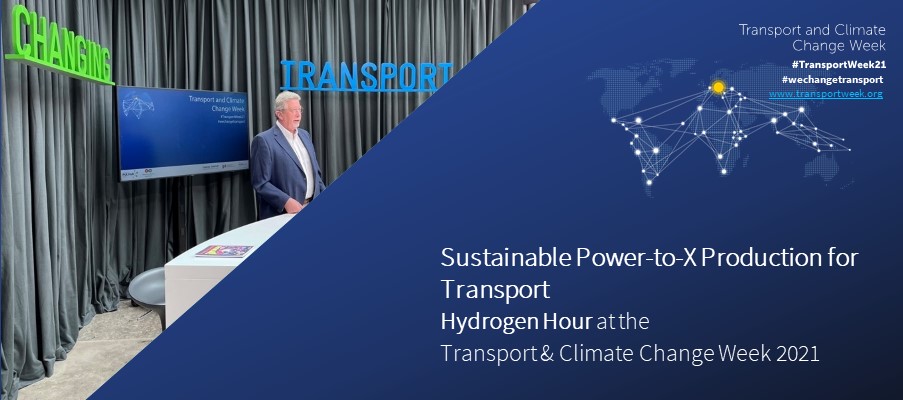How can the sustainability of Power-to-X fuels for transport be guaranteed? Moderator Heino von Meyer discussed sustainability considerations of Power-to-X with Dr. Dietrich Brockhagen from Atmosfair, Nino Berta from Climeworks and Ana Angel from HINICO in the second Hydrogen Hour of Transport and Climate Change Week 2021.
Round two of Hydrogen Hour kicked off on the 23rd of June 2021, with three hydrogen experts weighing in with their knowledge and insights on how to ensure sustainability in the production of Power-to-X fuels for the transport sector.
As hydrogen gains traction as a solution to defossilise high-emissions in transport – particularly aviation and maritime transport – this session unpacked the opportunities ahead and the risks to consider in order to guarantee sustainable Power-to-X production.
Power-to-X – the process of transforming renewable electricity into climate neutral fuels and chemicals – can only be considered sustainable if the CO2 and water utilised in the process do not contribute to increased greenhouse gas emissions or exacerbate water scarcities. These risks were underlined and addressed by all three speakers.
Starting the session, Heino von Meyer from the International PtX Hub Berlin spoke to Dr. Dietrich Brockhagen, the founder and CEO of Atmosfair, a climate protection initiative that offers companies and consumers the opportunity to offset their emissions. He argues that while compensation is certainly not sufficient to reach climate neutrality, it is a second-best solution to reducing emissions.
Dr. Dietrich Brockhagen tackled the crucial question of how Power-to-X production could exacerbate resource scarcities in the global South, stressing that the water and CO2 sources used in the production of synthetic E-fuels need to be sustainable. He views Direct Air Capture (DAC) as well as agricultural residues as sustainable solutions for sourcing CO2. Overall, both him and Heino von Meyer agree that international certification standards are necessary to regulate Power-to-X production and will play an important role in the export of green hydrogen and its derivatives from the global South to Europe.
Continuing on, Nino Berta explained the process of Direct Air Capture (DAC) – a technology for supplying the CO2 needed for Power-to-X production whilst ensuring a closed carbon circle. He outlined how his firm, Climeworks, uses DAC to capture CO2 and either store it underground or combine it with green hydrogen to produce syngas – which is then converted into synthetic E-fuels. He stressed the benefits of DAC in providing an unlimited supply of CO2 (unlike biofuels, for example, which are restricted by the availability of land and water) and highlighted how the combustion of synthetic E-fuels produced with CO2 from DAC releases the same levels of CO2 back into the environment as initially captured – therefore ensuring a closed carbon circle.
When questioned on the source of energy needed to power the DAC process, Nino emphasised the need to use renewable energy, as exemplified in Climeworks projects in Iceland where DAC is powered by geothermal energy, and near Zurich, where it relies on waste heat. He was also convinced that save solutions could be found for storing carbon permanently underground.
Following him Ana Angel from HINICO – a strategy consultancy on hydrogen– addressed concerns about Power-to-X projects in Latin America. She debunked the notion that Power-to-X might create water shortages in Chile, highlighting that just 0.6% of consumptive water in Chile would be sufficient to produce enough Power-to-X fuels to replace diesel, natural gas, liquified gas and gasoline across all sectors.
Ana Angel also highlighted the pivotal role Power-to-X can play in decarbonising economies across Latin America. She forecasted that in Costa Rica for example, there would be a 2.95 million ton decrease in CO2eq emissions by 2050 should the country power its economy exclusively with Power-to-X products. It’s a similar story for Mexico, with a possible reduction of 38 million tons of CO2eq emissions across all sectors by 2050.
In the Q&A, the risk of exploiting countries by exporting the resources needed for the production of Power-to-X fuels was again raised and the need to ensure clear benefits for partner countries emphasised. One idea to benefit local communities was to combine solar parks not only with DAC or Power-to-Liquid plants, but to make the electricity produced accessible to neighboring communities as well.
Nino Berta spoke about the potential to lower production costs of DAC collectors by mass manufacturing them – considering that they are about the size of a car and the car industry has successfully leveraged their potential for serial modular manufacturing.
Dr. Dietrich Brockhagen also highlighted desalination as a possible mitigation strategy against exacerbating water scarcities – with the technology readily available and easy to upscale with the support of investors. Like this, also local communities and farming activities could benefit.
The Hydrogen Hour was jointly organised by the International Power-to-X Hub Berlin, Women in Green Hydrogen and the Deutsche Gesellschaft für Internationale Zusammenarbeit (GIZ) GmbH.
The Transport & Climate Change Week is organised by the Deutsche Gesellschaft für Internationale Zusammenarbeit (GIZ) GmbH on behalf of the Federal Ministry for the Environment, Nature Conservation and Nuclear Safety (BMU) financed by the International Climate Initiative (IKI).
